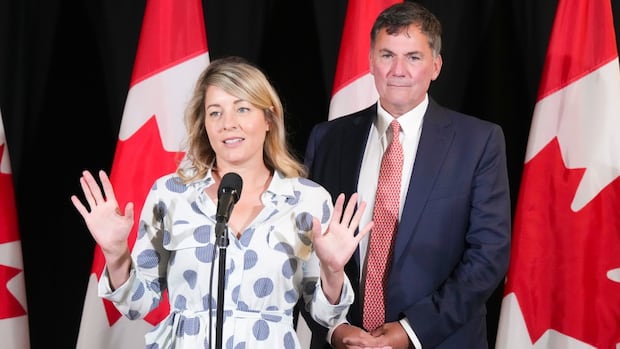Less than half of daycare spaces promised by Ottawa have been created ahead of 2026 deadline

The launch of a new national daycare program fuelled high hopes among Canadian families three years ago, but new figures show Ottawa is still a long way from meeting its goal of offering affordable spaces to “all families who need it” by 2026.
Despite its budget of $30 billion over five years, the federal daycare program suffers from underfunding, according to analysts, stakeholders and the Ontario government.
They warn that, without additional investments, Ottawa’s plan to create 250,000 new places at an average cost of $10 per day by the end of March 2026 may not be feasible.
According to the most recent figures obtained by Radio-Canada, the program has created child care spaces for 97,000 children since 2021 — just under 40 per cent of the overall goal.
The federal government has slightly more than two years left to create another 153,000 spaces and reduce their average cost to $10 a day in all provinces outside of Quebec, which already has a similar system in place.
Labour shortages and high inflation have made the target harder to reach, experts say.
A national daycare program was a flagship promise of Justin Trudeau’s Liberals in the 2021 election. Political analysts predict their record on this front will be a key point of debate with the Conservatives in the coming federal election campaign.
The program is federally funded, but provinces and territories have adopted different strategies to fulfil their agreements with Ottawa. Some of the smaller provinces, such as Newfoundland, Manitoba and Saskatchewan, have created $10-a-day spaces already, while others — including Ontario, Alberta and British Columbia — have managed to bring down costs by half.
An expert who has studied the Quebec model said the Liberal government’s project is particularly complex, given it relies on the collaboration of provinces and territories.
“In my opinion … to develop such a vast network across Canada should take at least 10 years. Especially given the incredible labour shortage that we’re facing,” said Nathalie Bigras, an expert in early childhood education at the Université du Québec à Montréal.
Some in government agree the program is facing headwinds.
“It’s major work … and I would suggest Rome was not built overnight, and this is a process. Hard things are hard, and this is one of those things,” said federal Minister of Families Jenna Sudds.
“There are absolutely challenges, but I would say the good and the worth that we were able to achieve [with the provinces] really triumphs on that.”
No more money coming from Ottawa: minister
She said Ottawa will not budge from its 2021 promises and insisted the government is “on track” to meet them. She also rejected provincial requests for additional funding, arguing the provinces also need to inject their own funds to ensure the program’s success.
“There is no new money to come. That’s a hard ‘no,’ unfortunately, at this point in time,” said Sudds, adding that federal transfers are already set to increase every year through the individual federal-provincial child-care agreements.
Ontario’s Education Minister Stephen Lecce said he will keep pushing Ottawa to put more money into the program and warned that the program’s initial targets and goals are at risk.
“In the absence of additional funding from the federal government, we are going to see longer wait lists and potentially more closures of [child-care] centres, which is diametrically opposed to the mandate of this program, which is affordability and access,” he said.
The Ontario government said it was unable to state how many of the 41,000 spaces created in the province since 2019 are subsidized under the national daycare program.
For parents who have access to the program, the savings are substantial.
Ontario parents with children in private daycares — where subsidies cover half of the cost of care and are uncapped — can save more than $10,000 per year.
But thousands of other parents in the province are still unable to find subsidized spots for their children.

“It’s upsetting,” said Amaryllis Pâquet, the mother of a 14-month-old in Ottawa who has been on a waiting list since her pregnancy. “I put a lot of effort into it, only to have nothing in the end.”
Her daughter is now in a private, unlicensed and unsubsidized daycare centre. She’s expecting a second child and said she doesn’t know if she’ll be able to stay in the workforce without subsidized child care.
“I’m left to wonder if I am going to pay over $1,600 in daycare [per month] or whether am I going to stay at home,” she said.
Sylvie Tourigny, who has more than 30 years of experience in the child-care sector, said she has seen a significant spike in demand for child care spaces in response to the new federal program.
As director-general of an Ottawa-based non-profit daycare provider, she oversees about 1,600 spaces in child-care centres and family settings. She said her services receive calls daily from “very desperate” parents seeking subsidized daycare.

“In the past, there were open spaces every now and then. Now … a family leaves on a Friday and on Monday there is already another family ready to receive their child-care services,” she said. “The demand is very high.”
Many experts feel that the creation of the program has driven demand for subsidized daycare. Statistics Canada reports growing demand for child-care spaces, with nearly 26 per cent of parents on a waiting list in 2023, up from 19 per cent in 2022.
Maggie Moser, owner of a private daycare in Toronto, said the program has created too much bureaucracy for providers in Ontario and gives them little in the way of incentives to expand their services or open new centres.
She said that with fees frozen to 2022 levels in the province, she is struggling to cover her costs. Moser said she has warned the parents of the 200 children in her daycare that she will withdraw from the program this fall.
While Ontario will be unveiling a new funding formula for the program in coming months, many child-care centres are worried about their financial sustainability right now.
“If the objective is to have a countrywide, universal childcare program at a cost of $10 a day and pay fair salaries to staff and remunerate people for building centres, and to carry the cost of creating all the spaces that are needed, there’s definitely not enough money in the program,” said Moser, a director of the Ontario Association of Independent Childcare Centers.
The YMCA, a non-profit organization that provides approximately 20 per cent of child care spaces in Ontario, said earlier this year that the situation “cannot be sustained.”
“Unfortunately, while cost savings are being offered to families, the cost burden on operators like the YMCA has grown,” the charity told the Ontario government in January.
The YMCA warns that, without changes, “many child care programs risk closing at a time when they should be expanding.”
Child care expansion is at risk, economist says
David Macdonald, a public policy expert who has studied daycare programs, said the main problems have hit the largest provinces outside Quebec — Ontario, British Columbia and Alberta.
“Expansion is a central part of this plan, and if we cannot do it, we will not get all the benefits,” said Macdonald, an economist at the Canadian Centre for Policy Alternatives. “At this point, it doesn’t seem like there is enough funding to increase salaries and create these new spaces, so we may have to revisit the funding for this program.”
Pierre Poilievre’s Conservative Party voted for the law that created the program — but is promising changes if it takes power in the next election, to end what it has called the “chaos” in child care.
The goal, according to a Conservative spokesperson, would be to ensure that “provinces and parents have the necessary choice and flexibility” to improve child-care services.
Sudds said that thousands of families are already benefiting from the program and thousands more will quickly join their ranks.
“That’s not chaos, that’s progress,” she said. “As we look to the next election, it’s scary to think that the Conservatives could destroy all of this progress that has been made since 2021.”
Political scientist Stéphanie Chouinard said child care could become “an important political issue” in the Greater Toronto Area, a crucial electoral battleground.
The professor at Kingston’s Royal Military College said the Liberals will have to defend their record, while the Conservatives will have to present a credible and reasonable alternative to the federal program.
“There’s a lot of frustration right now among families who have not benefited from this increased number of affordable daycare spaces. But there’s also a danger for the Official Opposition, because it’s not clear at the moment whether a Conservative government would want to continue funding child-care spaces at a lower cost,” said Chouinard.




